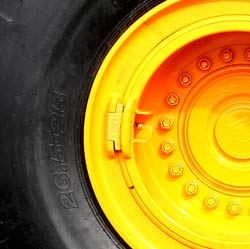Out-of-Balance Condition
 REMEMBER! Always balance tires and check for out-of-round wheels and tires prior to installing Ultraseal Tire Life Extender/SealerTire balance is most critical in high speed passenger vehicles and light trucks. Small front wheel drive passenger vehicles and light trucks are known to transmit more road, wheel and tire vibrations into the passenger compartment. A vehicle with good wheels and tires, when balanced, should take an average of three quarters to one and one half ounces of weight per tire. The need for an excessive amount of weight indicates a problem. Perform any corrective procedures prior to installing Ultraseal Tire Life Extender/Sealer. In this case, Ultraseal cannot correct the problem and, in fact, may amplify and increase vibration. Always visually inspect the tire for even and consistent tread as this is a common source of vibration. A simple method is to run the flat of your hand over the top of the tire tread (from front to back). If you feel an excessive amount of unevenness (saw tooth), then this tire is susceptible to vibration. This condition is often due to worn shocks and suspension causing the wheels to be out of alignment. Older tires that appear weather checked can absorb a little more Ultraseal than the average tire. In rare cases, slightly more Ultraseal should be installed (no more than 10%). It is not uncommon to experience a slight vibration between 65 and 70 mph during the first five miles driven after Ultraseal installation. This is normal and will subside within a few miles. Ultraseal's proprietary component "Thixogel" allows it to cling to the inner surface of a tire. Ultraseal resists adverse forces that attempt to pull it away and exaggerate any small vibration. Always balance tires PRIOR to installing Ultraseal. |





